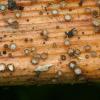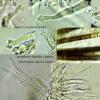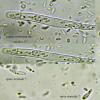
07-12-2025 16:07
Arnold BüschlenHallo, ich habe in einer Moos-Aufsammlung (epiohy

16-03-2014 22:00
Hello,I found this species a few months ago but ha

08-12-2025 13:39
Thomas Læssøehttps://svampe.databasen.org/observations/10572899

05-12-2025 17:33
 Bruno Coué
Bruno Coué
Bonjour, je serais heureux de recueillir votre avi

07-12-2025 09:24
De la pasada semana en Galicia EspañaEn el suelo

06-12-2025 00:19
 Viktorie Halasu
Viktorie Halasu
Hello, would anyone have this article, please? An
Trichopezizella rubroguttata (?) sur Polygonatum multiflorum
Bernard CLESSE,
03-02-2018 21:28
 Bonsoir tout le monde,
Bonsoir tout le monde,Trouvé récemment ce que je pense être Trichopezizella rubroguttata sur sceau de Salomon multiflore. Les asques ont systématiquement un crochet à la base.
Qu'en pensez-vous ?
Bernard
Hans-Otto Baral,
03-02-2018 21:46

Re : Trichopezizella rubroguttata (?) sur Polygonatum multiflorum
It is a good question, but the asci look a bit strange, their contents are guttulate unlike these Trichopezizellas. The asci are amyloid?
You don't find living asci and free spores?
You don't find living asci and free spores?
Bernard CLESSE,
03-02-2018 21:49

Re : Trichopezizella rubroguttata (?) sur Polygonatum multiflorum
Good evening Zotto,
The asci are IKI- and I have not found any spores, but lots of small conidia.
Bernard
Bernard CLESSE,
03-02-2018 21:52

Re : Trichopezizella rubroguttata (?) sur Polygonatum multiflorum
I'll double check if I see spores in other apothecia
Bernard
Bernard
Bernard CLESSE,
03-02-2018 22:31
Bernard CLESSE,
05-02-2018 14:49

Re : Trichopezizella rubroguttata (?) sur Polygonatum multiflorum
Hi Zotto,
Would you have a conclusion for this Trichopezizella with these asci and these strange spores ?
Bernard
Would you have a conclusion for this Trichopezizella with these asci and these strange spores ?
Bernard
Hans-Otto Baral,
05-02-2018 16:08

Re : Trichopezizella rubroguttata (?) sur Polygonatum multiflorum
Yes, now I have. It was my suspicion, but I wasn't sure at all. You have two organisms in one: T. nidulus with the hymenialparasite Helicogonium- I guess a new species.
Would be good to photograph more of the normal spores, they are actually the ascuspores. Especially the stage when they produce a terminal conidium is important since some species form conidia on the broader and and some on the narrower, but this is a bit variable.
In any case spore and conidial size should be measured.
You can consult my paper on the genus in Nova Hedwigia 69: 1-71.
I send it by mail.
Zotto
Would be good to photograph more of the normal spores, they are actually the ascuspores. Especially the stage when they produce a terminal conidium is important since some species form conidia on the broader and and some on the narrower, but this is a bit variable.
In any case spore and conidial size should be measured.
You can consult my paper on the genus in Nova Hedwigia 69: 1-71.
I send it by mail.
Zotto
Bernard CLESSE,
05-02-2018 16:14

Re : Trichopezizella rubroguttata (?) sur Polygonatum multiflorum
Interesting! I learn every day (I did not know there were parasitic fungi inside asci). I will wait for your mail to see more clearly.
Thank you very much, Zotto!
Hans-Otto Baral,
05-02-2018 17:28

Re : Trichopezizella rubroguttata (?) sur Polygonatum multiflorum
Not inside asci, the complete asci belong to the parasite. Therefore they are inamyloid (in all Helicogonium), and have croziers.
Bernard CLESSE,
05-02-2018 17:33

Re : Trichopezizella rubroguttata (?) sur Polygonatum multiflorum
Ah OK, Zotto, I understand better and so I photographed helicogonium asques ...
Thank you for your additional explanations
Bernard
Thank you for your additional explanations
Bernard



